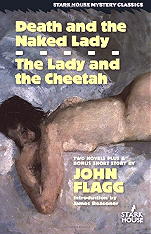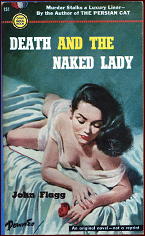Sun 18 Jun 2017
A STARK HOUSE Mystery Review: JOHN FLAGG – Death and the Naked Lady.
Posted by Steve under Reviews[2] Comments

JOHN FLAGG – Death and the Naked Lady. Stark House Press, trade paperback, 2017. Published in one volume with the novel The Lady and the Cheetah and the short story “Faces Turned Against Him.” Introduction by James Reasoner. First published as a Gold Medal paperback original in 1951 (#151).
John Flagg, not his real name, wrote eight paperback originals for Gold Medal back in the 1950s and early 60s. Before that, under his own name, John Gearon, he wrote one earlier work of crime fiction, The Velvet Well (Duell, hardcover, 1946) about about a man on the run from some former Nazis in South America.
Five of the Gold Medal books had a continuing series character named Hart Muldoon, a former OSS agent and man of mystery, or so I’m told, but he does not appear in either this novel or its companion novel in this recently published book from Stark House Press.
The protagonist in Death and the Naked Lady is a lounge singer named Mac McLean who, thanks to a few very fortunate turn of events, has become very popular in Europe and is on his way by ocean steamer to New York City and a lucrative engagement at the Persian Room there.

What he doesn’t know is that both murder and international intrigue are following closely on his heels. Telling his own story, if he’s not careful, he’s sure to be accused of being the killer of his close friend and sponsor, Georges Fournier.
Complicating matters are, first, a collection of jade owls he discovers in his possession, and then, not one, not two, but three beautiful women, all attractive and all (apparently) attracted to him. First, Lady Harcourt, whose husband Albert is a bore and does not seem to see what’s going on under his own nose; second, the stunningly beautiful Lili Fenwick, a girl from the Midwest who’s hit the top as a glamorous movie star; and third, the lady of the title, who made her name in the Folies Bergère but who is now married to a gentleman from Central America and who is rumored to be very powerful or very rich, or both.
Gearon/Flagg must have been very familiar with the jet transatlantic steamship set, circa 1950, since he describes the people and the boat they’re on so well. Compared with other authors in the Gold Medal stable at the time, he is better at writing than most. What he doesn’t seem to be able to create is the same flow of action as those do whose careers began in the pulp magazines (Bruno Fischer, Day Keene, Edward Aarons and so on).
That may be true for this book only, though. The story takes place almost entirely on board ship, and while it limits the number of suspects, it also feels cramped at times, with little room left for maneuvering.
Almost as big a mystery as who killed Fournier, and why did they frame McLean for the murder, is which of the three women will he end up with? My intuition was correct, I’m happy to say, or maybe that’s also because Flagg nailed their personalities, all very distinct, so well. Overall? A very enjoyable read.
June 18th, 2017 at 10:14 pm
I enjoyed the Flagg books, and second to my love of mysteries set on trains is a love of shipboard mysteries.
Granted Flagg lacked a few pulp skills, but he made up for them as a writer.
June 18th, 2017 at 10:25 pm
I usually like shipboard mysteries, too, and it’s been puzzling me as to why I was disappointed enough about that aspect of this one to say something about it.
I think now it started when McLean was on the run from the French homicide officer who was brought on board from a small boat. There are not all that many interesting places to hide on a ship.